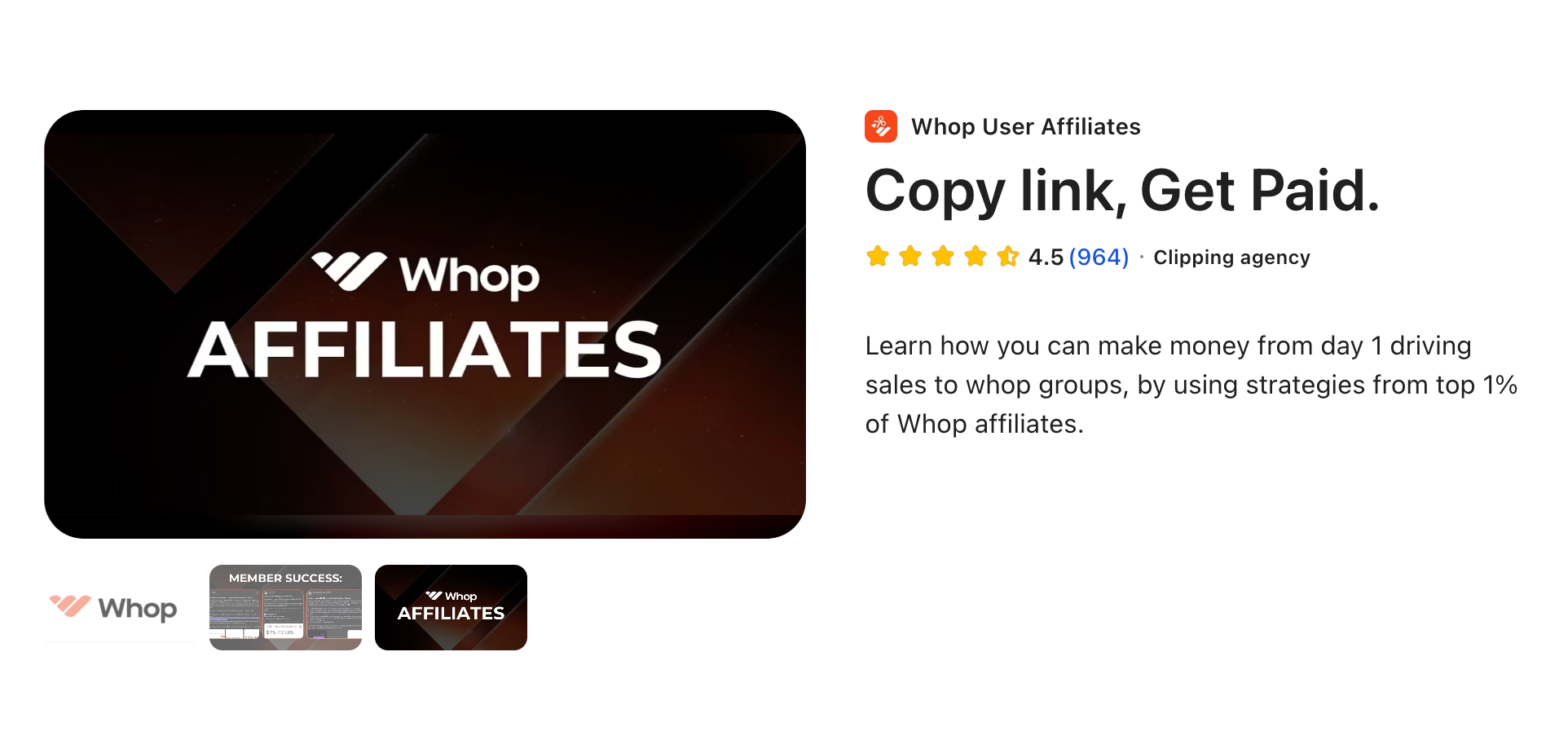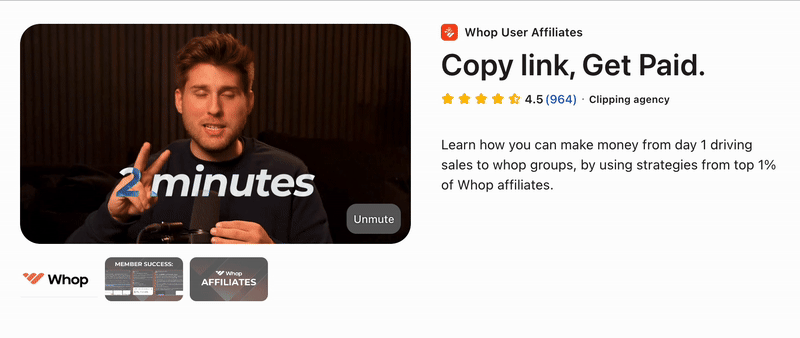Affiliate marketing works by promoting someone else’s product using a referral link and earning a commission when a customer makes a purchase. Learn how affiliate marketing works, how creators get paid, and how to start earning passive income online.
Key takeaways
- Affiliate marketing lets you earn commissions by promoting products without inventory, shipping, or customer service.
- Choose from three payment models: per sale (most common), per click, or per lead based on your content strategy.
- Build passive income by creating content like reviews, listicles, and videos that drive traffic to your affiliate links.
Affiliate marketing is one of the easiest and affordable ways to make money online. You promote someone else’s product, share a unique link or discount code, and earn a commission every time someone buys through it.
No inventory, no shipping, no customer service - no hassle.
It's a booming part of ecommerce because it lets anyone earn income without owning stock or running a business. All you need is an internet connection, a platform, and an audience interested in what you share.
In this guide, we’ll break down exactly how affiliate marketing works, why it’s so popular with creators, and how you can start your own affiliate business today.
How affiliate marketing works for creators
To make money with affiliate marketing you must first sign up for an affiliate program, then create your content, and finally insert your link and start sharing.
Here's a closer look at the steps involved:
1. Sign up for an affiliate program
The first stage of affiliate marketing is signing up for an affiliate program. There are several sites that offer these, including Amazon, who run its very popular Associates program. However, this program only provides its users with links to Amazon products.
Some programs host affiliate schemes for hundreds, sometimes thousands, of programs under one roof. This gives you a much broader choice of products to market through your content.
Signing up for affiliate programs tends to be straightforward, but not instant. A lot of schemes use application processes and require proof of where you will be hosting your affiliate links and codes.
Whop's affiliate program let's you make money from creators and customers
2. Create your content
Once you have been accepted into an affiliate program, it’s time to start creating the content in which your affiliate links will be found.
There are many different forms of content that affiliate marketers create:
- Listicles: Listicles make up a significant portion of affiliate marketing content. They are great for capturing an audience’s attention and give you a platform to showcase individual products and why they are worth buying.
- Case studies: Medium to long-form case studies detailing how a real-life individual benefited from using a product are effective for generating affiliate sales. You can go into depth about how effective a product is, using facts and emotion to back up your point.
- Reviews: Reviews allow you to hammer home exactly why your audience should buy a certain product. You can list pros and cons, as well as instructions on how to use it, leaving a link to buy at the end.
- Social media posts: It is very common to see someone using and reviewing a product on social media, with a link to buy the product. These videos are incredibly simple, mainly because of time restrictions on the various social media platforms.
- Emails: Sending affiliate links to your email list is an effective method of affiliate marketing. Providing you back the links up with engaging content that keeps the audience on your side, that is. After all, hard selling a product via email doesn’t tend to go down well with subscribers.
- Videos: YouTube is arguably the top online platform in the world, with over one billion hours of content being consumed on the site each day. This makes it a prime host for your affiliate content and links, which you could leave in the description box below the video.
Once your content highlighting a product is completed, it is then time to insert your affiliate links, discount codes, or coupons accordingly.
3. Inserting links and earning money
While most affiliate links work on a pay-per-sale basis, not every scheme works this way. Here are the three different types of affiliate link payment:
1. Per sale: This is the most common form of affiliate link, where you receive commission for every product sold using your link. This is also how it will work if you are offering a discount code for your audience to use at the checkout.
2. Per click: Some affiliate marketing programs will pay marketers a fee for every time somebody clicks on the affiliate link. The fees for this format are usually lower as clicks are more common than purchases.
3. Per lead: With the per lead model, you will receive commission every time someone clicks your link and signs up to a company. They’ll usually have to enter their email address and a password for you to receive a payment.
What is affiliate marketing?
Affiliate marketing is a revenue model where you promote another company’s product or service and get paid a commission for every sale made through your unique link or discount code.
It’s most common among content creators and bloggers who already have engaged audiences. Their followers trust their recommendations, which makes affiliate links a natural extension of the content they already create.
Watch this video and find out why AB thinks that affiliate marketing and Content Rewards are the best ways to make money
As AB says, affiliate marketing is one of the smoothest ways to start earning online - you're basically getting paid to recommend products you actually love.
"Let's say I have a cousin who wants to learn how to sell with TikTok shop. I can click on a whop, scroll to the bottom of the page, and add the affiliate reward to my dashboard.
Then, I copy my affiliate link, send to my cousin, friend, family member, and receive that reward straight into my Whop account."
- AB, Whop
There are two types of affiliate marketing:
Product links
One of the most common affiliate marketing methods is inserting affiliate links into content. These are often found on blogs and websites that produce content for a specific niche.
For example, an arts and crafts blogger may publish an article titled, ‘The 10 Best Paintbrushes’, posting links to buy each brush in the list. They would then receive money for everyone who clicks the link and buys the product.
Discount codes
Content creators and influencers are often sent products to review for free and given a discount code for followers to use at the checkout. They then make commissions on the products they advertise on Instagram, YouTube, and TikTok.
Why affiliate marketing makes sense for businesses
Affiliate marketing may appear as though it mainly caters for those earning commission from it, but it is also profitable for the businesses as it is low-cost and has a great reach
Here’s how:
- Cheaper than marketing campaigns: Generating affiliate links and paying commissions is considerably cheaper for businesses than rolling out marketing campaigns. If an affiliate link is used on multiple sites, awareness for the product will naturally increase.
- Gaining non-affiliate customers: While a lot of customers will be directed to the product via the affiliate link, it won’t always be the case. There will be a number of customers who make a mental note of it and search it up at a later date. This will void the original affiliate link, meaning the business will have gained a customer without having to pay commission.
- Reaching a desired demographic: Most affiliate marketers will operate in a specific niche, targeting content at a community of like-minded readers/viewers. This is ideal for businesses, as their product will land in front of the eyes of people who will be interested in buying it.
The best affiliate programs for making money online as a creator
1. Whop Affiliates

Whop’s affiliate program lets you earn recurring commissions by promoting products and communities hosted on the Whop marketplace. With thousands of offers available - from digital downloads and online courses to trading groups and coaching memberships - there’s something to fit almost any niche.
Signing up is completely free, and Whop gives affiliates access to real-time stats, transparent payouts, and consistent earnings for every referral that stays subscribed. It’s a simple, scalable way to build passive income from home.
Pros:
- Recurring commissions for ongoing referrals
- Free to join with instant setup
- Huge range of products and creator niches
- Detailed analytics and real-time tracking
Cons:
- Requires audience or traffic to earn effectively
- Limited to products sold on Whop’s marketplace
2. Rakuten advertising

Rakuten Advertising is one of the oldest affiliate marketing programs in the business, forming an impressive list of famous partners since it began in 2005. However, despite the notability of its partners, Rakuten lacks in options, with around 1000 businesses’ links on the platform.
This may feel like an issue for those operating in a less popular niche. However, if you want access to notable brands such as Kurt Geiger and New Balance, it could be the platform for you.
Pros:
- Lots of famous brand partnerships
- Pays well, depending on the merchant
- Great for beginners
Cons:
- Not a great deal of options
- Not ideal for those operating in more specific niches
3. Amazon associates

Amazon Associates is one of the most popular and well-subscribed affiliate programs in the world, which is understandable considering the size of its parent company. Because it is owned by Amazon, you can only provide links to Amazon products. This may originally feel like a flaw, but the site’s variety of products is almost endless.
The site offers one highly notable perk too. As well as receiving a commission on the product bought using your link, you’ll receive a commission on everything bought within the same shopping session.
It’s advised that you only join Amazon Associates once you have built an audience though. Amazon will remove you from the platform if you fail to make three sales in the first 180 days.
Pros:
- Huge variety of products to market
- Amazon is good at converting traffic to sales
- Commission received on the customer’s entire shop
Cons:
- If you fail to make three sales within 180 days, you get removed from the platform
- With commissions ranging from 1-4%, you’ll have to sell a lot to make decent money
- Each country pays separately and requires different minimum payment thresholds
4. FlexOffers

FlexOffers allows its users access to over 12,000 different affiliate marketing schemes, housing them all under one digital roof. With both high-end, luxury brands and smaller independent companies advertising their links on the platform, there’s plenty of variety to be found.
It’s completely free to sign up, although it will take 6% of your overall earnings and command a transaction fee when you withdraw money. This is frustrating, but with so many marketing schemes at your fingertips, the platform is worth consideration.
Pros:
- Multiple affiliate schemes to choose from
- Easy to keep track of all your affiliate programs
- Great for beginners
Cons:
- Payments take two months to arrive
- FlexOffers takes 6% of all earnings, plus transaction fees
- Minimum payment thresholds for withdrawal are high
Is affiliate marketing worth it?
Affiliate marketing can be an easy, low-cost way to earn online - but like any business model, it comes with trade-offs.
- What is high-ticket affiliate marketing? A complete guide for beginners
- High-ticket affiliate programs to turbocharge your earnings
Here’s a breakdown of the pros and cons before you dive in.
Pros
- Cost-effective to start: You don’t need to invest upfront. Most affiliate programs are free to join, and you can publish content on free platforms like YouTube, TikTok, or your own blog.
- Simple setup: Getting started usually just means applying to an affiliate network and sharing your unique link. Approval is quick and beginner-friendly.
- High income potential: The industry keeps growing as brands rely more on creators for marketing - which means more earning opportunities for affiliates.
- Endless niches: From finance and fitness to gaming and home decor, there’s no shortage of affiliate products to promote.
- Passive income: Once your content gains traction, your links can earn around the clock, even while you sleep.
Cons
- No guaranteed success: You only earn when someone buys through your link, so results depend on your ability to drive real traffic and conversions.
- Crowded space: With so many people trying affiliate marketing, it takes creativity and consistency to stand out.
- Lost commissions: Some users may click your link, then buy later without it - meaning you miss out on the sale.
- Time-intensive: It’s cheap to start but not quick. Building content, trust, and traffic can take months before you see meaningful returns.
Affiliate marketing with Whop: the easy way to earn passive income

If you’re ready to start your journey in affiliate marketing, Whop has got you covered. Whop’s affiliate program pays you for referring others to products hosted on the Whop marketplace.
With a huge range of products spanning from digital coloring books to sports betting communities, Whop has something to suit every affiliate marketer’s niche. We’ll also provide you with detailed statistics and the ability to earn recurring payments for your referrals.
Become a Whop Affiliate today and start earning a scalable side income without leaving your home.



